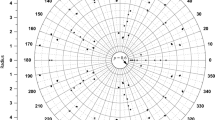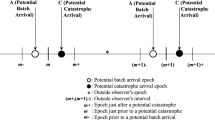Abstract
We consider a stochastic model where a population grows in batches according to renewal arrival process. The population is prone to be affected by catastrophes which occur according to Poisson process. The catastrophe starts the destruction of the population sequentially, with one individual at a time, with probability p. This process comes to an end when the first individual survives or when the entire population is eliminated. Using supplementary variable and difference equation method we obtain explicit expressions of population size distribution in steady-state at pre-arrival and arbitrary epochs, in terms of roots of the associated characteristic equation. Besides, we prove that the distribution at pre-arrival epoch is asymptotically geometric. Based on our theoretical work we present few numerical results to demonstrate the efficiency of our methodology. We also investigate the impact of different parameters on the behavior of the model through some numerical examples.
Similar content being viewed by others
References
Artalejo JR, Economou A, Lopez-Herrero M (2007) Evaluating growth measures in an immigration process subject to binomial and geometric catastrophes. Math Biosci Eng 4(4):573–594
Brockwell PJ, Gani J, Resnick SI (1982) Birth, immigration and catastrophe processes. Adv Appl Probab 14(4):709–731
Dabrowski C (2015) Catastrophic event phenomena in communication networks: a survey. Computer Science Review 18:10–45
Di Crescenzo A, Giorno V, Nobile AG, Ricciardi LM (2008) A note on birth–death processes with catastrophes. Statistics & Probability Letters 78(14):2248–2257
Dimou S, Economou A (2013) The single server queue with catastrophes and geometric reneging. Methodol Comput Appl Probab 15(3):595–621
Economou A (2003) On the control of a compound immigration process through total catastrophes. Eur J Oper Res 147(3):522–529
Economou A (2004) The compound poisson immigration process subject to binomial catastrophes. J Appl Probab 41(2):508–523
Economou A, Fakinos D (2003) A continuous-time markov chain under the influence of a regulating point process and applications in stochastic models with catastrophes. Eur J Oper Res 149(3):625–640
Economou A, Gómez-Corral A (2007) The batch markovian arrival process subject to renewal generated geometric catastrophes. Stoch Model 23(2):211–233
Elaydi S (2005) An introduction to difference equations. Springer, New York
Feller W (1968) An introduction to probability theory and its applications vol 1. Wiley, New York
Gross D, Harris C (1985) Fundamentals of queueing theory. Wiley, New York
Kapodistria S, Phung-Duc T, Resing J (2016) Linear birth/immigration-death process with binomial catastrophes. Probability in the Engineering and Informational Sciences 30(1):79–111
Krinik A, Rubino G, Marcus D, Swift RJ, Kasfy H, Lam H (2005) Dual processes to solve single server systems. Journal of Statistical Planning and Inference 135(1):121–147
Kumar BK, Arivudainambi D (2000) Transient solution of an \({M/M/1}\) queue with catastrophes. Computers & Mathematics with Applications 40(10-11):1233–1240
Kyriakidis EG, Dimitrakos TD (2005) Computation of the optimal policy for the control of a compound immigration process through total catastrophes. Methodol Comput Appl Probab 7(1):97–118
Lee C (2000) The density of the extinction probability of a time homogeneous linear birth and death process under the influence of randomly occurring disasters. Math Biosci 164(1):93–102
Neuts MF (1994) An interesting random walk on the non-negative integers. J Appl Probab 31(1):48–58
Shafer CL (2001) Inter-reserve distance. Biol Conserv 100(2):215–227
Singh G, Gupta U, Chaudhry ML (2016) Detailed computational analysis of queueing-time distributions of the \({{{BMAP}}/g/1}\) queue using roots. J Appl Probab 53(4):1078–1097
Spiegel M (1971) Theory and Problems of Calculus of Finite Differences and Difference Equations (Schaum’s Outline Series). McGraw-Hill Book Company
Acknowledgments
The authors F. P. Barbhuiya and Nitin Kumar are grateful to Indian Institute of Technology Kharagpur, India for the financial support. The authors would like to thank the editor and two anonymous referees for their valuable remarks and suggestions which led to the paper in current form.
Author information
Authors and Affiliations
Corresponding author
Appendix
Appendix
Theorem 2
The equation \(z^{b} - A^{*}\Big (\frac {\mu p (1-z)}{1-pz} \Big ) {\sum }_{i = 1}^{b} g_{i} z^{b-i} = 0\)hasexactly b roots inside the unit circle \(|z|= 1\).
Proof
We assume \(f(z)=z^{b}\) and \(g(z)= - A^{*}\Big (\frac {\mu p (1-z)}{1-pz} \Big ) {\sum }_{i = 1}^{b} g_{i} z^{b-i}\). Let \(K(z)=A^{*}\Big (\frac {\mu p (1-z)}{1-pz} \Big )\). Here \(A^{*}\Big (\frac {\mu p (1-z)}{1-pz} \Big )\) is an analytic function in \(|z| \leq 1\) which can be expressed in the form \(K(z)={\sum }_{i = 0}^{\infty }k_{i}z^{i}, \) where the coefficients \(k_{i}= \frac {K^{(i)}(0)}{i!}\) are such that \(k_{i} \geq 0~~ \forall ~ i \geq 0\). Consider the circle \(|z|= 1- \delta \) where \(\delta >0\) and is sufficiently small. Now
Since \(\lambda \bar {g}(1-p)< \mu p\) and \(\delta \) is a very small quantity, we have \(|g(z)|<|f(z)|\) on the circle \(|z|= 1- \delta \). Thus, from Rouch\(\acute {e}\)’s theorem we can say that f(z) and \(f(z)+g(z)\) have exactly b zeroes inside the unit circle. □
Rights and permissions
About this article
Cite this article
Barbhuiya, F.P., Kumar, N. & Gupta, U.C. Batch Renewal Arrival Process Subject to Geometric Catastrophes. Methodol Comput Appl Probab 21, 69–83 (2019). https://doi.org/10.1007/s11009-018-9643-2
Received:
Revised:
Accepted:
Published:
Issue Date:
DOI: https://doi.org/10.1007/s11009-018-9643-2




